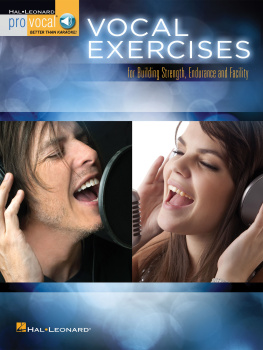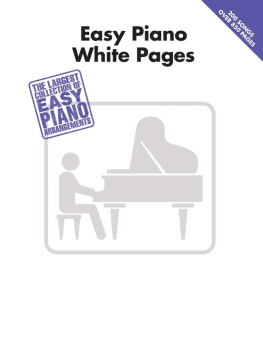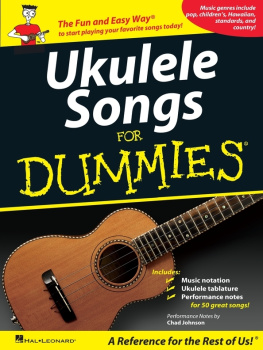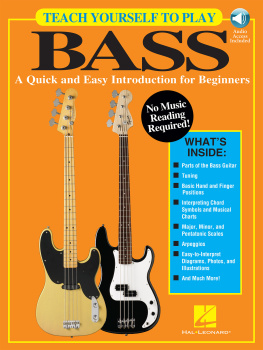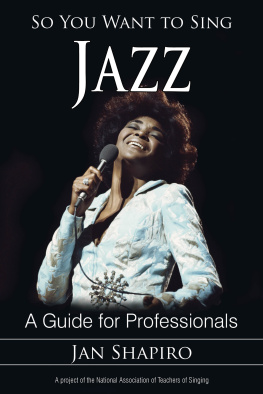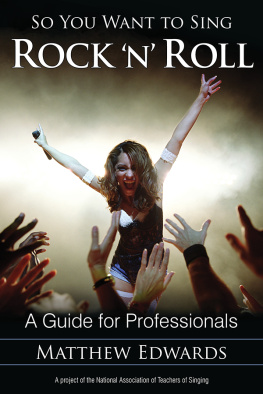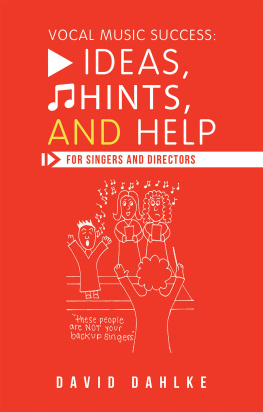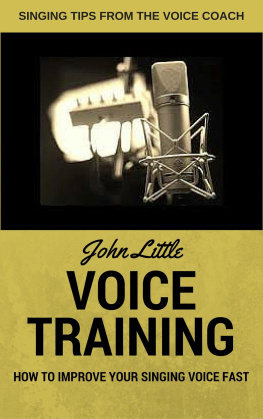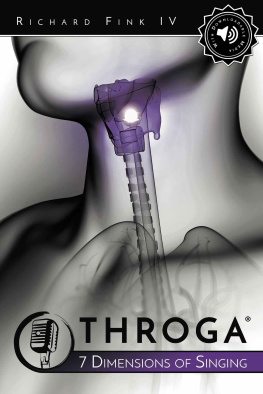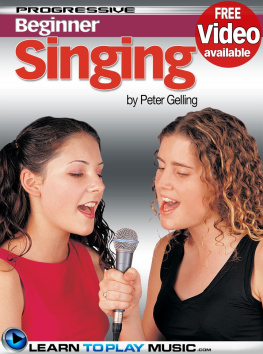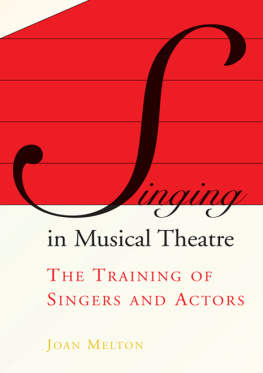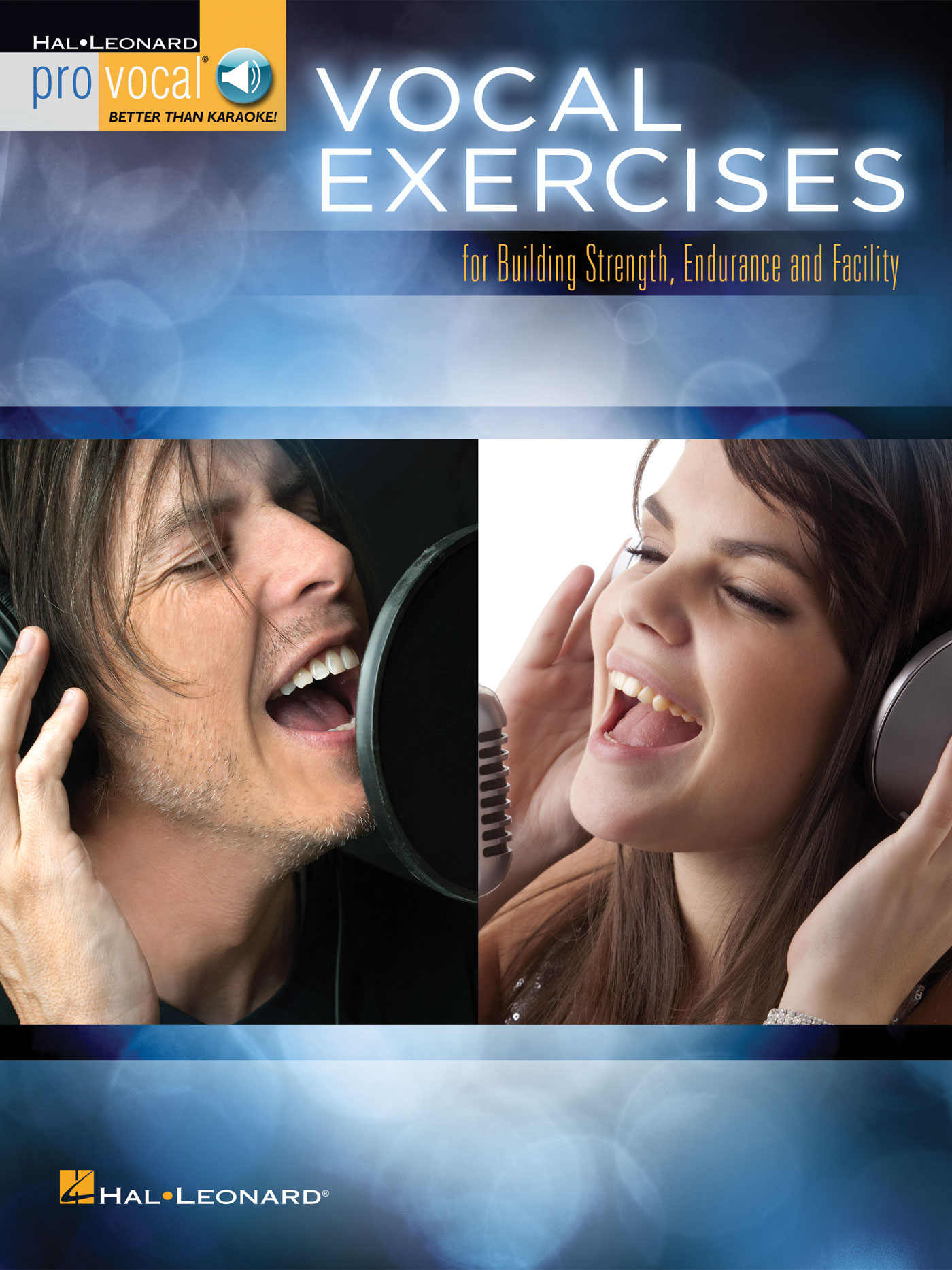ISBN 978-1-4803-9951-8
In Australia Contact:
Hal Leonard Australia Pty. Ltd.
4 Lentara Court
Cheltenham, Victoria, 3192 Australia
Email: ausadmin@halleonard.com.au
For all works contained herein:
Unauthorized copying, arranging, adapting, recording, Internet posting, public performance,
or other distribution of the printed or recorded music in this publication is an infringement of copyright.
Infringers are liable under the law.
Visit Hal Leonard Online at
www.halleonard.com
Building Vocal Strength
Vocal strength is essential to producing a good sound, singing with control and confidence, as well as singing for many years. A weak voice is one that tires easily, one that is inconsistent in sound quality and/or pitch and dynamics, and one that gives out many years before the singer is ready to stop singing. Vocal strength is not all about singing loudly. Its about singing well.
The exercises and musical selections in this book are designed to help singers hone and refine their skills to develop the kind of control and consistency professional singers need to compete and find work. But mastering these skills is not just a task for professional singers amateur singers who work on the exercises in this book will find singing easier and more fun with each new level of control they achieve.
These exercises are intended to be added to an existing daily vocal warm-up routine, one at a time. Once you have mastered the skill in the exercise, keep the exercise in your warm-up routine, but work on it a few times a week, rather than daily. As you finish with one, begin on another, which you will also take to an a-few-times-a-week status after youve mastered it.
The walking and core strengthening exercises can remain part of your everyday routine whether or not you practice on that given day.
Vocal strength means endurance, no tension, breath control, technical control, fluidity/facility basically ease in everything you do as a singer.
After youve made your way through the book, you may want to pick and choose a few of the exercises that are particularly helpful to music youre performing and include them in your pre-gig warm-up routine.
Exercise 1
Basics
For any professional musician, making music is all a matter of habits. From the way musicians stand or sit when they make music to the way they breathe and produce sound, everything they do is a carefully taught, finely disciplined habit.
One of your most important singing habits is that of good posture. Your posture affects your sound, because it affects the way you breathe. Your singing posture is important not only when you walk onstage to perform, but also when youre practicing, taking a lesson or coaching, or participating in a rehearsal. Rehearsals can be the most difficult places to maintain good posture, simply because you cant take a break to stretch or move around when you want to. By the end of a rehearsal you may be tired and you may have to fight to maintain good posture.
Good singing posture, whether sitting or standing, is relaxed, with a straight spine and neck. Hips are directly underneath the shoulders, with the pelvis neither tilted to the front or back. When standing, feet are shoulder width apart. When sitting, feet are flat on the floor.
Try the following breathing exercise using good and bad standing posture and good and bad sitting posture. Youll understand the importance of good posture immediately.
Placing one hand on your chest and one on your abdomen, exhale slowly until your lungs feel quite empty. Now inhale three times, without exhaling in between, thinking about filling up your lungs in thirds. After the last breath, you lungs should feel quite full. Take two quick inhalesthrough your nose, which should give you a feeling of being slightly overfull of air. Exhale slowly and gently, relaxing as you do so. This is a great exercise to add to daily and pre-gig warm-ups.
Exercise 2
In Goes the Good Air
Singers talk a lot about breathing from the diaphragm and about supporting their sound. Although you never want your diaphragm control to be a tense, rigid process, you do need to know where your diaphragm is and what it feels like when its working.
To locate your diaphragm and to wake it up, place you hand on your abdomen and utter a loud, indignant Hah! Go ahead, really make a statement with it. You should feel you diaphragm work to expel a blast of air for the Hah.
Now lets put the breath support weve been practicing to use on actual notes. Stand, with your hand on abdomen. Sing the octaves shown, starting on a pitch that is comfortable in your range. When the high octave starts to feel like youre reaching for it, stop and sing them in reverse, high note to low note. Your hand will feel your diaphragm working differently for the low and high notes. It can also help you stay relaxed and make the shifts from low to high and from high to low both smoothly and easily.
High Voice There is audio content at this location that is not currently supported for your device. The caption for this content is displayed below.
High Voice There is audio content at this location that is not currently supported for your device. The caption for this content is displayed below.
Low Voice There is audio content at this location that is not currently supported for your device. The caption for this content is displayed below.
Low Voice There is audio content at this location that is not currently supported for your device. The caption for this content is displayed below.
For all the exercises in this book: Sopranos and tenors should begin with the high-voice vocalises; altos and baritones should begin with the low-voice vocalises. As you progress and as your vocal range increases, you may wish to do both sets of exercises. However, if an exercise gets too high or too low for you, if your throat feels tight, if you start straining, or if you cant hit the note, just stop and use the range (high or low) that is comfortable. After some work, you might be able to go higher or lower. Remember, everyones voice is different. Develop yours to its unique potential.
Exercise 3
Hold That Note
Your diaphragm is the engine that powers your voice. It moves air in and out of your lungs and allows you to sing without damaging your voice. Repeat the hah exercise introduced in exercise 2 to wake up your diaphragm. In this exercise you are going to work on controlling the flow of air from your lungs without tensing the diaphragm.
To work on relaxed, even breath control, stand up, let your arms hang loose at your sides and take a deep, soothing breath. Exhale on a very soft, controlled sss sound, until you need to breathe again. Its not as easy as it sounds. When you first begin doing this exercise, you are likely to notice that the sss sound is uneven and sometimes shaky. Dont tense up it wont help. Do it again, always with a deep, relaxed inhale and soft steady sss sound. The more you work on this, the easier it gets.

